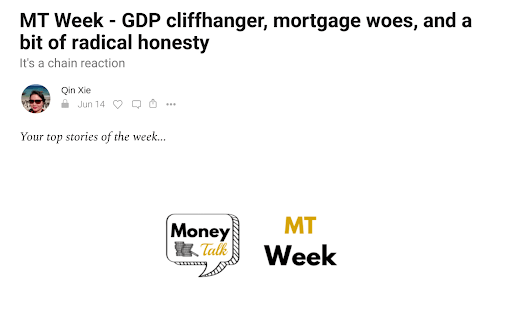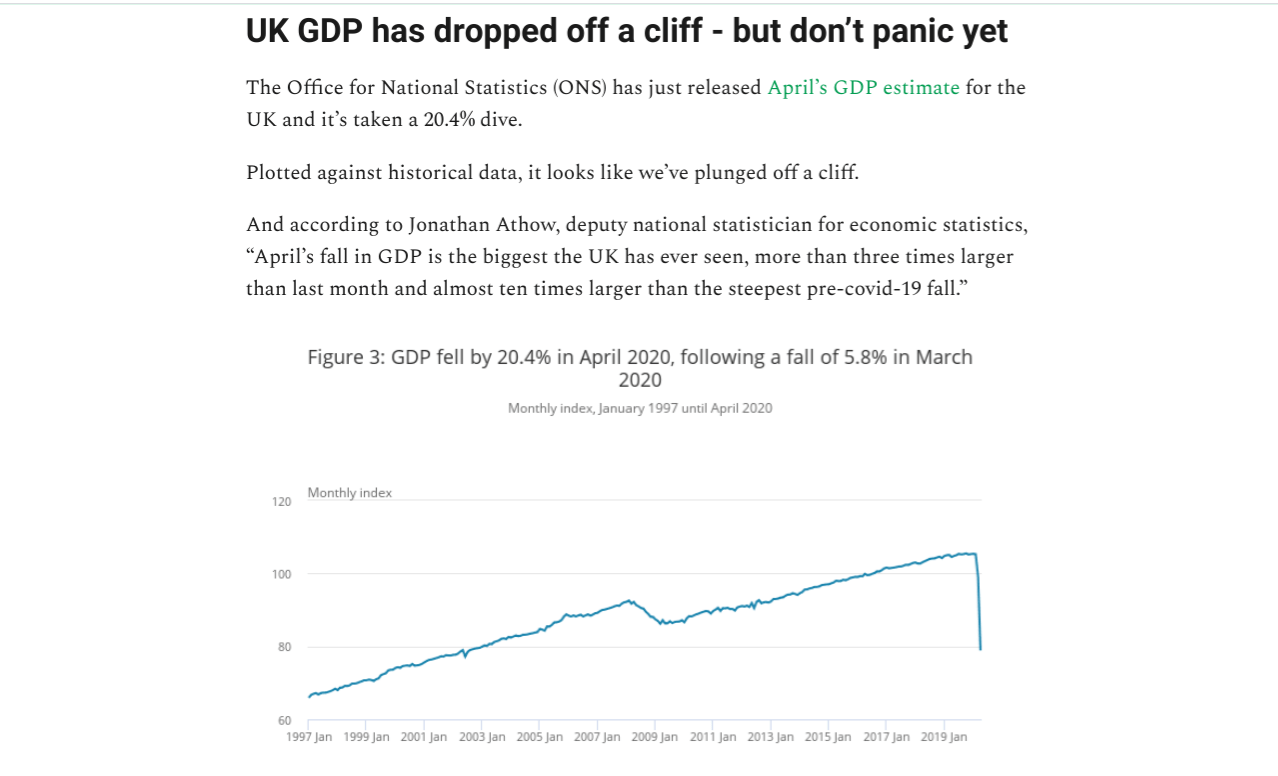How I Got Paying Newsletter Subscribers On Launch Day
Hi there! Who are you and what’s your background?
Hi, I’m Qin Xie, a journalist and editor based in London.
I recently launched Money Talk, a reader-funded newsletter on the highs and lows of personal finance.
At the moment this is my side hustle, but I’m hoping it will turn into a main gig in the future.
Writing about personal finance is completely new to me - my normal beat is food and travel, which I’ve been reporting on for the last 10 years for the likes of The Independent, CNN, Lonely Planet, Conde Nast Traveller and more.
It feels like a huge tangent but when I started this newsletter, I realised how much personal finance knowledge I already had from just being an avid consumer of money content, writing about consumer rights in a travel context and having studied philosophy and economics at university.
What’s your newsletter about?
So the tagline for the newsletter is the highs and lows of personal finance - it’s a bit of a play on the fact that the economy moves in cycles of peaks and troughs. It’s a mixture of news, tips, advice and analysis split into three different parts.
MT Week is a weekly curated round up of the most important money news delivered on Sunday mornings.
MT Focus is a monthly deep-dive into a topic such as savings, debt or pensions. It’s a mixture of analysis and interviews with experts sent out in the middle of each month.
MT Alert is all the ad hoc alerts that you might want to action. For example, if a bank is dropping their interest rates. I explain what the news means and some of the things you might want to do.
Paid subscribers get all three while free subscribers just get MT Alerts.
Money Talk is written for a British audience in mind but beyond that, it could be for anyone.
The reality is, everyone’s in such different situations financially and it doesn’t always relate to how much money you make - you can make £100k a year and still be in debt. That’s why Money Talk covers the spectrum: from pensions and investing to debt and savings.

When did you get started writing your newsletter? What motivated you to get started?
It’s coming up to the one-month anniversary of Money Talk and looking back, it feels a lot like serendipity.
Newsletters as a medium had been in the back of my mind for some time - lots of people seemed to be doing it and they were by and large very popular. But I wasn’t sure whether it was for me because I had nothing to sell or promote.
Then one night, I was browsing online and spotted this post on Substack, on how the journalism industry was being decimated.
It had been a particularly brutal week of job losses for journalists around the world due to coronavirus so it really struck a chord with me. And it was also poignant because it highlighted the fact that actually, the newsletter itself could be a product.
When I read that post, I was on furlough from my day job. The timing was just right - I had an idea and I had the time so I just went with it.
What does the process of writing your newsletter look like for you?
For MT Week, which is the weekly newsletter, I usually make a start of it on Friday. I go through the week’s news stories, which I get sent to my inbox, and decide what might be worth including.
The actual writing starts on Saturday, because Money Talk is scheduled to go out on Sunday mornings. This means if there’s anything major going on at the end of the week, I can catch it too.
I’ll usually read several different versions of a story and I always go to the original source of the report to pick out the most interesting bits and then add my spin on it. It takes me pretty much the whole day to put it together because I want the advice I give to be considered and not a hot take.
The behind the scenes stuff is pretty much all done on Google. Google Docs for the writing and Gmail for emailing. And I’m even working on a Chromebook.
The only non-Google tool I used was Canva, which I used to create my logo.
I also have an accompanying podcast, which is just excerpts of the newsletter at the moment. But in about six months, I’m going to introduce some new and exclusive content for subscribers. For that, I use a Roland R5 to record and Audacity to edit.
What are some of the difficulties you’ve encountered in running your newsletter?
The newsletter thing is so new to me so it’s been a steep learning curve. And because I launched straight into a paid version - Substack suggests launching a free version first and once you have enough traction, convert to a paid version - the hill is even harder to climb.
The other thing you have to fight is that people are so used to getting content for free. In the middle of a global pandemic, how many are willing to pay for it?
When I launched the project, I hand picked around 200 people to receive my first post, which explained why I was launching the project. They’re all friends or colleagues who I thought would appreciate getting the news. Some of my first paid subscribers have come from this list.
But the number of free and paying subscribers to Money Talk is steadily growing, which is promising. It shows that those who have subscribed are already sharing it with friends and family, who are also signing up.
I think the quality of the output has a lot to do with it - the open rate hasn’t fallen below 64% yet and I’m seeing people opening it a second, third and even 10 or 15 times.
In less than a month, it’s already made £100, which, considering there was zero content when it launched, and a monthly subscription is just £3.65, I’m pretty pleased with.
What have you learned through writing your newsletter?
Quite a lot! I personally digest a lot of news for work and I think I’m pretty financially savvy. But in writing Money Talk, I realised just how much I’ve missed because I’m too busy doing other things.
Like the ever changing rate of savings accounts for example. And there are financial products being introduced and pulled all the time.
This is all stuff that I’m now sending directly to my subscribers. It’s up to them how they manage their money of course but I’ve given them the facts, the options and the advice, which puts them in a pretty good place to make an informed decision.
Since launching this project, I’ve also become a bit of a marketeer! I’ve attended a lot of webinars on how to expand your network and share your work. I can’t say they’ve all helped but you never know.
Launching the accompanying podcast, for example, was off the back of a webinar I attended before Money Talk was even a nugget of an idea. But now it’s central to how I’m promoting Money Talk to wider audiences.

How do you grow your audience?
So far, incoming subscriptions have been mostly through word of mouth. The email I sent introducing Money Talk to friends and colleagues really helped too. I wrote about the process on Indie Hackers.
I also shared the news on social media, including LinkedIn, which has been a great resource. But because I didn’t have a product yet - I hadn’t put out the first subscriber post at this point - it was a bit of a hard sell.
This is another reason why I’m so amazed that people signed up in the early days; they trusted that I would make a great product without ever having seen it.
Now that I do have a few posts, it’s a bit of an easier sell. I also have a small ad campaign on LinkedIn lined up - I was offered some free ad credits - so I’m going to see how that works out.
Less than a month in, I have around 70 free subscribers, and 10 paying subscribers. I think this is a pretty good number given I’m not known for writing about money.
What newsletters are you subscribed to?
I mostly subscribe to newsletters for work. Aside from the ones I get from governments, businesses and people I want to write for, I get The Professional Freelancer and Freelance Writing Jobs.
I’m still learning about the newsletter-for-fun side of things so happy to get recommendations.
What goals do you have for the future?
I really hope that Money Talk can move from a side hustle to the main gig.
So far I’ve really enjoyed doing it and have already made some new friends in communities that I wouldn’t have accessed before. I have a lot of ideas for content - from podcasts to events - that I want to introduce.
But as I also need to make a living, the premise is having enough subscriber support to make that happen.
Where can readers go to learn more about you and your newsletter?
I’m on Twitter, Instagram and Facebook and Money Talk is also on Twitter, Instagram and Facebook.
You can read all about Money Talk and follow my “founder journey” on Indie Hackers.



